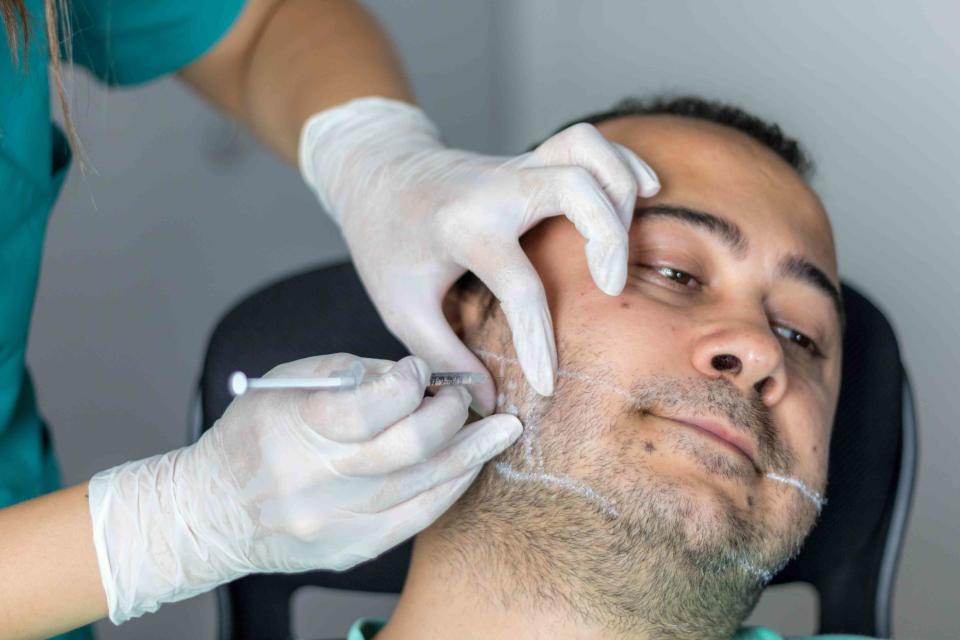What You Need to Know About Masseter Botox
Botox injected in the jaw muscle

Okan Celik / Getty Images
Medically reviewed by Brian T. Luong, DMD
Botox is the brand name for botulinum toxin type A. It is a neurotoxin that blocks nerve signals to the muscle when injected. Botox is commonly used to reduce facial wrinkles but is also used in treating certain medical conditions.
The masseter muscles are jaw muscles that control closing the mouth. Masseter Botox is injected into the masseter muscles to treat various medical conditions of the jaw and head. This article will discuss masseter Botox's uses, procedures, and side effects.

Okan Celik / Getty Images
What Are the Uses of Masseter Botox?
Masseter Botox, sometimes called jaw Botox, treats several conditions caused by tightened masseter muscles. This includes teeth grinding, clenching, jaw pain, and headaches. Masseter Botox is also used for cosmetic purposes to slim the face down by reducing the size of the jaw muscles.
Teeth Grinding
Teeth grinding, medically known as bruxism, is the tightening and grinding of teeth while awake or asleep. Sleep-related bruxism is a common condition that affects 15–40% of children and 8–10% of adults.
Traditional treatments for teeth grinding have included mouth guards, medications, and cognitive-behavioral therapy. A 2019 study found that Botox injected into the masseter muscle was more effective at treating bruxism than traditional methods are. Botox decreases the grinding force and frequency of bruxism and minimizes pain.
Jaw Pain and Clenching
The temporomandibular joint (TMJ) is the jaw joint that connects the jaw to the sides of the head.
Temporomandibular joint dysfunction (TMD) is characterized by jaw muscle and joint pain. It can also cause the jaw to feel stiff and jaw locking and clicking.
Jaw pain and clenching is a common problem that affects 5–12% of the population.
Researchers in a 2016 study confirmed that Botox injected into the masseter muscle decreased jaw pain and clenching.
Headaches
Tension headaches are the most common type of headache and the most common condition associated with TMD. These headaches are caused by muscle tension and tightness. Symptoms include:
Pain on both sides of the head
Pain that comes on gradually
Dull pain
Feeling like a band is tightening around the head
Mild to moderate pain (not severe)
Masseter Botox can treat TMD by relieving tension in the muscles around the temples.
Changing Face Shape
The masseter muscles give the jawline its square shape. Botox injected into the masseter muscles weakens the muscles and can soften the shape of the face, making it appear slimmer.
There are several other areas of the face where a Botox injection can change it. When injected into other facial muscles, Botox can reduce how big someone can smile, thereby reducing how much of their gums show.
The Masseter Botox Procedure
Receiving Botox in the masseter muscles is a quick procedure that does not require a hospital visit.
Before the Procedure
Before someone receives masseter Botox, they should consult a healthcare provider. The healthcare provider will ask about medical history, medications, and allergies. They will also discuss the patient's desired outcomes as well as potential procedure complications.
During the Procedure: What to Expect
Masseter Botox is injected in a healthcare provider's office. The procedure takes approximately 15 minutes.
The healthcare provider will clean the areas to be injected during the procedure. They may apply numbing cream to the injection area. Then, a tiny needle will inject the Botox into the masseter muscles. The number of injections and amount of Botox injected for each will vary from person to person.
After Treatment
After the procedure, there is no recovery or downtime.
It is very important to avoid rubbing or massaging the injection area. This can cause the Botox to move into other areas of the face. If this occurs, facial weakness or drooping can occur.
The injections will take a few days to a week to fully take effect. The Botox will last for three to four months.
Benefits of Masseter Botox
Masseter Botox treats several conditions and offers cosmetic benefits as well. Below are all the benefits of the procedure:
Side Effects of Masseter Botox
Masseter Botox is a safe and common procedure, but there are certain side effects users should be aware of, including:
Pain and bruising at the injection site
Flu symptoms
Temporary facial drooping or weakness
Masseter Botox will not ruin a smile or change other facial features as long as the Botox does not migrate into other areas of the face.
How to Find Someone Who Is Qualified to Offer Masseter Botox Treatment
To find the right healthcare provider to administer masseter Botox, look for someone who is board certified in plastic surgery or dermatology and has experience with using Botox for masseter muscle concerns.
To find a board-certified plastic surgeon or dermatologist, ask for a referral from a primary care healthcare provider or other providers. Before committing to a specific healthcare provider, ask about their experience and success using Botox on the masseter muscles.
Summary
Masseter Botox is used for cosmetic purposes and to treat medical conditions caused by the jaw muscles, such as teeth grinding, tension headaches, and jaw pain. It is done in a healthcare provider's office and takes about 15 minutes. There is little to no downtime, and most people can go back to their normal activities afterward. A healthcare provider who specializes in Botox administration can help determine if this treatment is right for your situation.

